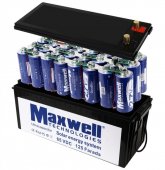Hedges
I See Electromagnetic Fields!
- Joined
- Mar 28, 2020
- Messages
- 20,679
VFD are relatively inexpensive. Some power transistors, no big magnetics.
It is the motors which are usually expensive. I found a new in the box 2 HP pool pump motor for $100 so the total package cost me $300 (plus a used 3R enclosure for the electronics outside.)
Since then variable speed pool pumps became common. About $1200, but they have features like detecting of someone got sucked onto an inlet, and shutting off.
I wanted variable speed because at 3600 RPM the pump strains, sometimes cavitates, and at 1800 RPM (I previously used a 2-speed) almost no flow through the filter.
120/208Y at 20A per leg would deliver 50% more power than 120/240V split phase at 20A per leg. 3-phase would need one more wire than a 240 only connection, same as 3-wire 120/240 which doesn't carry full current on all wires at the same time.
A stove or dryer on two legs 208V would draw less current, less power. A motor would draw more current, same power.
Generally 3-phase equipment is going to cost more than high volume consumer split-phase products. Sometimes deals are to be had on used shop tools that are 3-phase.
VFD rather than 3-phase converters are the way to go. But they may cause problems for high frequency inverters. One of my threw an error when it saw the load. At first I thought harmonics, but then I realized it is probably the spike of current near peak voltage which is drawn by rectifier/capacitor input circuit.
It is the motors which are usually expensive. I found a new in the box 2 HP pool pump motor for $100 so the total package cost me $300 (plus a used 3R enclosure for the electronics outside.)
Since then variable speed pool pumps became common. About $1200, but they have features like detecting of someone got sucked onto an inlet, and shutting off.
I wanted variable speed because at 3600 RPM the pump strains, sometimes cavitates, and at 1800 RPM (I previously used a 2-speed) almost no flow through the filter.
120/208Y at 20A per leg would deliver 50% more power than 120/240V split phase at 20A per leg. 3-phase would need one more wire than a 240 only connection, same as 3-wire 120/240 which doesn't carry full current on all wires at the same time.
A stove or dryer on two legs 208V would draw less current, less power. A motor would draw more current, same power.
Generally 3-phase equipment is going to cost more than high volume consumer split-phase products. Sometimes deals are to be had on used shop tools that are 3-phase.
VFD rather than 3-phase converters are the way to go. But they may cause problems for high frequency inverters. One of my threw an error when it saw the load. At first I thought harmonics, but then I realized it is probably the spike of current near peak voltage which is drawn by rectifier/capacitor input circuit.





